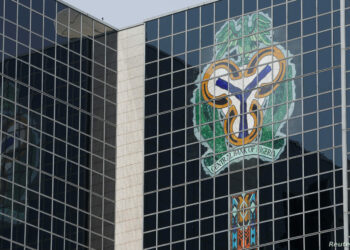The Central Bank of Nigeria (CBN) has signaled a decisive turn in monetary policy as its Monetary Policy Committee (MPC) trimmed the benchmark interest rate for the first time in over two years, easing credit conditions in a bid to stimulate growth in the real economy.
At the end of its two-day meeting in Abuja, the MPC reduced the Monetary Policy Rate (MPR) by 50 basis points to 27 per cent, while cutting the Cash Reserve Ratio (CRR) for deposit money banks from 50 to 45 per cent. The Committee also adjusted the asymmetric corridor around the MPR to +250/-250 basis points, a move widely seen as a deliberate signal of an accommodative stance.
In a balancing act, however, the CBN introduced a new 75 per cent CRR on non-Treasury Single Account (TSA) public sector deposits, in an effort to sterilise excess liquidity arising from higher government revenues and monthly allocations. The liquidity ratio was retained at 30 per cent, while the CRR for merchant banks remained unchanged at 16 per cent.
The latest policy shift comes against the backdrop of five consecutive months of moderating inflation, supported by a stable exchange rate, bumper harvests, and improved fiscal revenues. According to the MPC communique, headline inflation has eased steadily since May, driven largely by slower food price increases and relative exchange rate stability.
Speaking at the end of the meeting last week, CBN governor, Olayemi Cardoso, noted that the Committee’s decision to lower the monetary policy rate was predicated on the sustained disinflation recorded in the past five months, projections of declining inflation for the rest of 2025 and the need to support economic recovery efforts.
Commenting on the decision of the MPC, former member of the committee and an economist, Prof. Michael Obadan, described the move as both logical and overdue. Noting that he would have recommended the same direction, he said, “For a long time, policy had become too tight and constraining, particularly for real sector development. With high interest rates compared to returns in the public sector, businesses were highly constrained.”
He added that the 50bps reduction, though modest, is significant as a signal that the CBN is now willing to begin unwinding its aggressive tightening stance. “The reduction in the CRR from 50 per cent to 45 per cent is particularly welcome.
“The previous level was far too constraining—half of every deposit had to be sterilised with the CBN, creating a double burden for banks who still had to pay depositors while funds were unavailable for lending. This change should ease pressures and free up liquidity for credit creation.”
On the new 75 per cent CRR for non-TSA public sector deposits, Obadan was more cautious. “Perhaps the authorities have more information on agencies that hold huge deposits in commercial banks. It may be a way of preventing such funds from distorting the banking system,” he said.
Investment bank Cordros Capital said the MPC’s action reflected “optimism over recent improvements in key macroeconomic indicators, which are expected to remain favourable in the near term.”
The firm noted that while easing conditions for the private sector, the CBN remains wary of fiscal-driven liquidity injections that could derail the disinflation process. “We believe the move strengthens monetary policy transmission, mitigates risks of currency speculation, and reinforces the disinflationary trend,” Cordros stated.
Looking ahead, Cordros projected further monetary easing as inflation declines more sharply. “Headline inflation is likely to trend towards 18 per cent by October, which may warrant a more decisive adjustment at the November MPC meeting. We anticipate a 100bps cut at that time.”
In market terms, the firm said the decision could trigger a broad-based moderation in yields across fixed-income instruments. “OMO and NTB yields will likely pare as liquidity improves, while mid-tenor bonds may benefit the most from stronger demand. Lower sovereign benchmarks will cascade into the corporate debt market, reducing borrowing costs and supporting refinancing activity.”
The chef executive of Centre for the Promotion of Private Enterprise (CPPE), Dr Muda Yusuf, on his part hailed the policy as a “timely intervention” that will unlock credit and stimulate investment. “High interest rates in recent quarters significantly constrained private sector credit, raised the cost of funds, and weighed on business expansion. By lowering the MPR and CRR, the CBN is deliberately working to improve liquidity conditions, reduce borrowing costs, and unlock capital for productive sectors of the economy.”
Yusuf cautioned, however, that complementary fiscal measures are needed to sustain the gains. “The fiscal authorities must prioritise infrastructure, consolidate the fiscal position, and decisively address insecurity. These remain critical to creating a business-friendly environment that attracts both domestic and foreign investment.”
He described the new 75 per cent CRR on non-TSA public deposits as “a prudent safeguard against fiscal-driven liquidity shocks that could undermine stability.”
Head of Financial Institutions Ratings at Agusto & Co, Ayokunle Olubunmi, noted that the MPC’s action is within a broader global trend. “The decision largely signals an accommodating stance, similar to moves by central banks in developed economies and even across Africa,” he said.
He warned, however, that the response of foreign investors will depend on treasury bill and OMO rates. “If yields maintain a downward trajectory, foreign portfolio investors (FPIs) might be concerned, although the bullish trend in the equities market still provides opportunities for returns.”
Obadan echoed this caution. “Portfolio investors generally desire high interest rates. The high MPR had helped attract them into government securities. As rates come down, they may not find it as attractive. But in truth, Nigeria should not rely on portfolio flows. What the country truly needs is foreign direct investment, which depends on improving the operating environment.”
For the CBN, the task now is to sustain the disinflation trend while supporting growth. The communiqué noted that the decision to impose a higher CRR on public deposits was designed to neutralise the impact of rising government revenues and prevent liquidity surges from destabilising the naira.
“The Committee believes the combination of measures will ease financing conditions for the private sector while safeguarding macroeconomic stability,” the statement said.
With inflation expected to moderate further, analysts anticipate a gradual but steady easing cycle. Markets are already pricing in a dovish shift, with expectations of lower yields and stronger corporate issuance in the months ahead.





